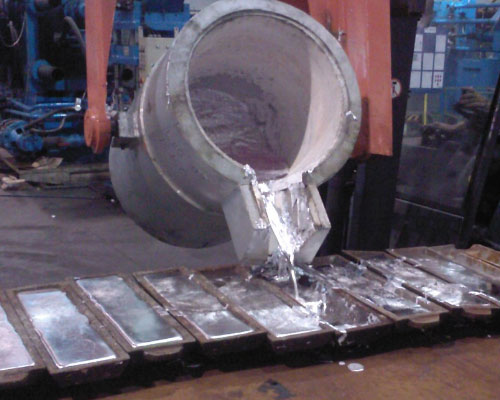Aluminum continuous casting can be divided into mixed furnace casting and external casting.
Mixing furnace casting is the process of casting molten aluminum into the mixing furnace, and is mainly used to produce aluminum ingots for remelting and casting alloys.
Outer casting is carried out directly from the ladle to the casting machine, which is mainly used when the casting equipment cannot meet the production requirements or the quality of the incoming materials is too poor to be directly fed into the furnace. Since there is no external heating source, it is required that the ladle has a certain temperature, generally between 690°C and 740°C in summer and 700°C to 760°C in winter to ensure that the aluminum ingot has a better appearance.
For casting in the mixing furnace, the ingredients must first be mixed, then poured into the mixing furnace, stirred evenly, and then added with flux for refining. The casting alloy ingot must be clarified for more than 30 minutes, and the slag can be cast after clarification. AdTech fluxes include granular fluxes and powder fluxes, which have very good refining effects and are widely used in aluminum foundries.

During aluminum continuous casting, the furnace eye of the mixing furnace is aligned with the second and third molds of the casting machine, which can ensure a certain degree of mobility when the liquid flow changes and the mold is changed. The furnace eye and the casting machine are connected with a launder. It is better to have a shorter launder, which can reduce aluminum oxidation and avoid vortex and splashing. When the casting machine is stopped for more than 48 hours, the mold should be preheated for 4 hours before restarting.
The molten aluminum flows into the mold through the launder, and the oxide film on the surface of the molten aluminum is removed with a shovel, which is called slagging. After one mold is filled, the launder is moved to the next mold, and the casting machine advances continuously. The mold advances in sequence, and the molten aluminum gradually cools down. When it reaches the middle of the casting machine, the molten aluminum has solidified into aluminum ingots, which are marked with a melting number by the printer. When the aluminum ingot reaches the top of the casting machine, it has completely solidified into an aluminum ingot. At this time, the casting mold is turned over and the aluminum ingot is released from the mold.
The launder and trough supplied by AdTech can reduce the secondary pollution of the aluminum liquid, and the aluminum ingot mold coating can help the aluminum ingot to be demolded smoothly. AdTech also produces on-line degassing filtration equipment that can reduce hydrogen and impurities in molten aluminum.

